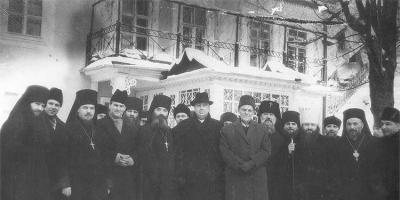There are settlements where, for a number of reasons, there are power outages. Such situations arise especially often in holiday villages in winter time of the year. To heat your home, you have to look for models of devices that work without power that meet your requirements.
Modern manufacturers produce such devices - this is a double-circuit non-volatile gas boiler. It can not only heat the room, but also cook hot water in the required quantity, and will also fit perfectly into any interior.
What is this device?
 A non-volatile boiler does not depend on the supply of electricity and can operate in its absence. Some consider it to be outdated equipment, although this is incorrect. Foreign manufacturers produce modern models such devices that are not inferior in efficiency to energy-dependent boilers.
A non-volatile boiler does not depend on the supply of electricity and can operate in its absence. Some consider it to be outdated equipment, although this is incorrect. Foreign manufacturers produce modern models such devices that are not inferior in efficiency to energy-dependent boilers.
Their feature is the ability to work only with heating systems in which the coolant moves by gravity.
When heated in the boiler, the water rises, enters the outlet pipe and further into the system. During circulation, it cools down and movement can be stopped. To prevent this from happening, pipes are used large diameter and place them at an angle.
To improve the operation of a non-volatile boiler, circulation pumps can be used, which, when installed in the system, move coolant through it. They operate only on electricity; when they are turned off, the system goes by gravity.
 There are two types of non-volatile gas double-circuit boiler:
There are two types of non-volatile gas double-circuit boiler:
- floor
- wall
It performs the same functions as conventional devices and can be used for installation in small spaces.
Features of operation of non-volatile equipment
Such devices have two burners - pilot and main. Pressing the button activates the piezoelectric element. It ignites the pilot burner, and it ignites the main burner. The latter, when burning fuel, heats the heat exchanger and operates until the water reaches the set temperature.
Then the gas supply decreases and the burner goes out. When the heat exchanger cools down, the temperature sensor is triggered again and the process repeats. Modern models of energy-independent boilers have a valve that shuts off the gas supply in the event of a complete or partial absence of draft. It is designed to reduce the safety level of the devices.
Heating equipment manufacturers
 are not in such great demand as conventional devices. But they are in demand in areas where there are frequent power outages.
are not in such great demand as conventional devices. But they are in demand in areas where there are frequent power outages.
Moreover, they are used not only for heating residential buildings, but also such objects where the presence of energy-dependent devices is undesirable, for example in saunas and baths.
The main manufacturers of such boilers today are:
- Protherm (Czech Republic)
- Alphatherm (Italy)
- Attack (Slovakia)
- Beretta (Italy)
They are also produced by local manufacturers, but their products are not in such demand as foreign models.
Distinctive features
 The difference between normal gas apparatus and those that work without electricity is obvious. It lies in the complete absence of the need for it. This results in the ability to work without additional devices such as an uninterruptible power supply.
The difference between normal gas apparatus and those that work without electricity is obvious. It lies in the complete absence of the need for it. This results in the ability to work without additional devices such as an uninterruptible power supply.
Such boilers have a small number of components and assemblies and are quite lightweight, which allows them to be hung on a wall from any building material. Having small dimensions, they fit organically into overall design premises.
All non-volatile boilers have high efficiency. This made these devices more attractive to potential buyers. The advantages include their safety and simple installation, which distinguishes these models from volatile and steam boilers.
However, this equipment is not without its drawbacks. These include:
- specialized requirements for the heating system
- presence of a chimney with good draft
- additional ventilation device in the room to remove combustion products
- sufficient pressure level in the gas line
Which type is better to choose?
Like conventional boiler equipment, devices of this class are divided into:
- double-circuit
 The former only perform heating of the premises, while the latter also provide the residents with hot water. Its preparation can be carried out in one of two ways:
The former only perform heating of the premises, while the latter also provide the residents with hot water. Its preparation can be carried out in one of two ways:
- flow-through
- cumulative
This is the first thing to consider when choosing. However, other characteristics, such as power, should not be neglected.
 They also differ in cost. Models from foreign manufacturers are made in modern design and have advanced equipment, and, consequently, a high price. For those who purchase a non-volatile boiler for their dacha, it may be better to opt for products from local manufacturers; they are not inferior in quality to imported ones, but are cheaper.
They also differ in cost. Models from foreign manufacturers are made in modern design and have advanced equipment, and, consequently, a high price. For those who purchase a non-volatile boiler for their dacha, it may be better to opt for products from local manufacturers; they are not inferior in quality to imported ones, but are cheaper.
And one more aspect that should not be underestimated. At the time of buying gas equipment you need to focus on the service base and the availability of spare parts.
Therefore, before you go to buy a boiler, find out if there are service centers for this model in your city.
Having considered all the advantages and disadvantages of a non-volatile model of a gas heating device, we can say that it is simply irreplaceable in areas where there are problems with electricity. And also in those rooms where the presence of an electrical network and devices operating from it is undesirable. Such boilers are the most profitable equipment option for country house, saunas and other premises.
A gas boiler without electricity is a traditional model of a floor-standing appliance that does not require additional energy sources to operate. It is advisable to install devices of this type if there are regular power outages. For example, this is relevant in rural areas or dacha areas. Manufacturing companies produce modern models of double-circuit boilers.
They have reduced gas consumption, as well as the ability to adjust heating.
Many popular manufacturers produce different models energy-independent gas boilers, and they are quite efficient and of high quality. IN Lately appeared wall models such devices. The design of the heating system must be such that the coolant circulates according to the principle of convection.
This means that the heated water rises up and enters the system through the pipe. To ensure that the circulation does not stop, the pipes must be placed at an angle, and they must also be large in diameter. And, of course, it is very important that the gas boiler itself is located at the lowest point of the heating system.
A pump that is powered from the mains can be connected separately to such heating equipment. By connecting it to the heating system, it will pump coolant, thereby improving the operation of the boiler. And if you turn off the pump, the coolant will again begin to circulate by gravity.
Boiler design without electricity
The gas boiler, independent of electricity, has:
- 2 gas burners – pilot and main;
- Combustion chamber - in such devices it is open for better traction;
- Automation;
- Boiler safety system - temperature sensor, backdraft valve (it is needed to regulate the operation of the chimney);
- Heat exchanger.
The system of a non-volatile gas boiler must have an open expansion tank, since when the coolant heats up, the liquid expands. And this is what promotes coolant circulation. But during expansion, excess is formed, which enters this tank.
Ignition in such gas boilers occurs using a piezoelectric element, which operates when a button is pressed. With its help, the pilot burner is ignited, and the main burner is ignited from it. gas-burner, thanks to which the heat exchanger heats up and the desired liquid temperature is maintained.
After some time, the gas does not flow and the burner goes out, after the heat exchanger has cooled down the process repeats.
Advantages and disadvantages of independent boilers
The main advantage of this gas boiler is the lack of connection to the electrical network. Since this is an additional saving and there is no need to connect an outlet.
It should be noted that these devices are easy to use. And also system security. This type of boiler is the simplest. And suitable for heating like small house, and large rooms.
Quiet operation of a dual-circuit device independent of electricity is ensured by the absence of pumps. Such devices are reliable and durable. This can be explained by the fact that such boilers have been produced for a long time and their operation has been tested in practice for more than one year. An independent boiler produces high efficiency. A double-circuit boiler easily provides the desired temperature in the house, as well as hot water.
In such devices, the heat exchanger lasts much longer than in other models of gas boilers.
Let us note the disadvantages of such a boiler:
A gas boiler independent of electricity should only be installed in a house with good chimney draft. This is absolutely necessary for the safe and high-quality operation of the device. If the draft is insufficient, the fire will constantly go out due to the backdraft valve being activated.
If you have an independent gas boiler, it is not always heating system works as expected. For example, if you install pipes of the wrong diameter or do not calculate their desired location. All these factors are very important. It is better to design a heating system for a specific gas boiler, then there is a guarantee that no failures will occur.
Boiler operation
Since there is no access to electricity, the double-circuit boiler has a thermogenerator that stops the gas supply to the burner. This occurs when the heat carrier is exposed to the regulator. The automation resumes the gas supply to the boiler when the coolant cools down to a certain temperature.
Ignition occurs using a piezoelectric element, which ignites the ignition burner (it burns constantly) and, if necessary, the main heat source is ignited from it. It helps heat the fluid in the heating system.
Types of independent gas boilers
The following types of boilers operating without electricity can be distinguished:
- single-circuit– apply only to the heating system;
- double-circuit- These are devices that, in addition to heating, also provide hot water for household needs.
 Rice. 1
Rice. 1Double-circuit gas boilers, in turn, provide hot water in 2 ways: flow-through and storage.
Selecting an independent boiler model
Gas boilers operating without electricity must fully correspond to the area of the heated room. That is, the power must match the load.
Dual-circuit models foreign manufacturing companies are often more expensive than domestic ones, as they are more advanced and have an attractive design. The manufacturer of the gas boiler must be chosen carefully; it is important to make sure that this company has a service center in the city or nearby. Since, if necessary, you can find spare parts for repairing the device there.
The most popular manufacturers of such equipment are Alphatherm, Beretta - Italy, Attack - Slovakia, Protherm - Czech Republic, Electrolux - Sweden.
Rice. 2Domestic models of independent boilers are cheaper than foreign ones, but are considered less reliable. But we should pay tribute that such devices are already adapted to our weather conditions and the parameters under which they must operate.
A gas boiler without electricity can be chosen with a steel or cast iron heat exchanger. The most popular are cast iron devices. This is explained by the service life: cast iron will last 30 years, and steel 15-20 years.
Cast iron is not only stronger, but the design also means that the walls of such a heat exchanger are thicker. This prevents the walls of the heat exchanger from burning through. This device has been tested in practice.
The heat exchanger may also be subject to corrosion. Cast iron appliance much less susceptible to such damage, unlike steel. Corrosion on the heat exchanger appears if the temperature drops to the point that condensation appears. And this very moisture leads to corrosion processes.
Also, the cast iron heat exchanger, by its design, consists of sections. If necessary, you can change a section, not the entire device. Nowadays, impurities are added to the cast iron alloy, which make it even stronger. This means that it will not crack if transported incorrectly.
Rules for installing a gas boiler
It is better to install a gas boiler independent of electricity in separate rooms with a good ventilation system, and also ensure air flow there. Because due to the open combustion chamber, air is constantly “eaten up” by the boiler. Combustion products are discharged through the chimney.
 Rice. 3
Rice. 3When installing a wall-mounted independent gas boiler, a coaxial chimney is installed, the design of which is called “pipe in pipe”. A coaxial chimney is not suitable for all devices and requires specialist advice.
If necessary, you can install circulation pump. Mount it via bypass. It is recommended to install taps near it: 1 at the entrance and 1 at the exit. A tap is placed separately on the main line, which must be closed when the pump is running. If such taps are available, if necessary, you can repair the pump without draining the water from the system. It is recommended to install a filter in front of the pump.
There are certain conditions that must be maintained:
- the boiler room must have a positive temperature;
- fire safety. The walls in the boiler room must be equipped with non-flammable material. As a rule, asbestos or metal sheets.
- The first start-up of the boiler after installation should be carried out under the supervision of a specialist.
A specialist should also check that the chimney is installed correctly. It is necessary that it corresponds to the power of a gas boiler without electricity and to the standards established by competent organizations. It is better to have a separate pipe for each heating device. According to the standard, the chimney should be straight; if it is impossible to make it this way, then there should be no more than 3 turns.
The length of the chimney should be about 5 meters. The heating unit must be selected and installed in accordance with the pressure in the gas pipeline, usually it is 1.270 MPa. The documentation that comes with the device (passport) always indicates the acceptable limits of this indicator. Sometimes gas pressure readings decrease in winter. Knowing this feature of the region, you need to select a device without access to electricity accordingly.
The climate control company Termomir offers a wide range of heating boilers various types and countries of production - Russia, Germany, Italy, Czech Republic, etc. Read the information or call our consultants to choose the right boiler model.
A heating boiler is a device that, using the combustion of fuel (or electricity), heats the coolant for water heating of premises through a system of batteries and radiators.
The boilers are designed for heating rooms with an area of 30 sq. m. m and up to several thousand. Household low-power heating boilers used for heating and hot water supply of private and country houses, cottages, dachas, garages, workshops, cafes and restaurants, schools and other educational and children's institutions, as well as swimming pools, baths and saunas. In addition, they are used for individual apartment heating.
Production and industrial boilers are designed for heating workshops, warehouses, hangars, enterprises, and other large buildings and premises. For very large objects in the heating system, it is allowed to combine boilers in a cascade of two or more devices.
Small and simple boilers heating systems can be placed in the basement, attic, garage, even in the kitchen and bathroom. Installation of floor-standing boilers high power recommended in a separate boiler room. Some boiler models have outdoor (outdoor) installation.
Modern boilers of the new generation are equipped with programmable control units with various automatic settings and functions (for example, a weather-dependent control system), as well as devices for remote control of the boiler - a GSM module (regulation of the operation of the device via SMS messages).
The selection of heating boilers is carried out according to the main parameters: required heating area and boiler power, type of energy carrier, number of heating circuits, type of combustion chamber, type of burner, type of installation, steel or cast iron heat exchanger, etc.
To determine the power of a heating boiler for heating a house or apartment, a simple formula is used - 1 kW of boiler power for heating 10 m 2 of a well-insulated room with a ceiling height of up to 3 m. Accordingly, if heating is required basement, glazed winter garden, rooms with non-standard ceilings, etc. The boiler power must be increased. It is also recommended to increase the power (about 20-50%) when providing a boiler and hot water supply (especially if it is necessary to heat the water in the pool). Our consultants will help you accurately calculate the boiler power based on the heating area.
Comparison of heating boilers by type of fuel:
"Economy class"- inexpensive and simple boilers, service life is shorter than that of boilers of a higher category. Some manufacturers have budget boiler models, for example,
Boiler Protherm 40 TLO (35 kW)
Heating systems independent of electricity are installed in areas and settlements where there are serious problems with energy supply. Installing a non-volatile gas boiler is the only way to save comfortable temperature in room. These devices are used in gravity heating systems, where the coolant circulates through pipes under the influence of gravity and thermal expansion of water. Equipment manufacturers offer single- and double-circuit versions of such devices.
Operating principle of the boiler
The equipment does not require connection to a power source. Structurally, it contains a thermogenerator. When gas is supplied to the combustion chamber using piezo ignition (triggered by pressing a button), the pilot burner ignites. It burns constantly, providing ignition of the main heat source if necessary. It, in fact, heats the water in the heating system.
The coolant heated to a certain temperature acts on the thermostat, which turns off the gas supply to the main fireplace. By giving off heat, the water cools and activates the gas supply mechanism. The gas supply is resumed, and it ignites from the “standby” burner.
Functional benefits
The fact that a non-volatile gas boiler can operate without electricity is not the only advantage of the device. The design of its chimney also ensures the safe operation of such equipment. The channels provide installation of sensors that determine the level of traction. If it decreases or if reverse flow occurs, the gas supply to the combustion chamber automatically stops.
Design and operational features provide other advantages of such boilers:
- automatic flame intensity control;
- presence of piezo ignition;
- long service life of the heat exchanger;
- maintaining functionality even with a significant decrease in gas pressure in the system.
Many models are equipped with a remote control remote control, which makes their use even more convenient.
Installation Requirements
 Double-circuit gas boiler
Double-circuit gas boiler Single- and double-circuit non-volatile heating boilers are installed in accordance with the requirements that ensure natural circulation of the coolant.
These include:
- Mandatory compliance with the slopes of pipelines in which water circulates.
- Using a large diameter pipe to reduce resistance along the coolant path.
- Additional installation into the system expansion tank, where excess heated water will fall.
In addition, it is necessary to strictly adhere to the standards for the installation of gas equipment. In particular, this applies to the installation of ventilation and exhaust gas removal systems.
Important! If the requirements and norms of state standards are violated, carbon monoxide may accumulate in the room. This is dangerous not only for health, but also for the lives of all family members.
Involving persons who are not authorized for this type of work in the installation of the system is strictly prohibited. All work is carried out by specialists who have passed the appropriate accreditation.
Boiler model options
A non-volatile floor-standing boiler is more popular among consumers than its wall-mounted counterpart. It is distinguished by its simplicity of design and reliable operation. Manufacturers offer equipment different power, which allows you to select best option For small dacha and for apartments over 200 square meters.
 Floor standing gas boiler
Floor standing gas boiler Install non-volatile floor-standing boilers in a separate room, where you can easily arrange a good supply ventilation. The open combustion chamber takes air from the room, and exhaust gases are discharged through the chimney.
If it is not possible to allocate a separate room or build a furnace room, then you should purchase a wall-mounted analogue. Relatively recently, suppliers began to offer non-volatile gas wall-mounted boilers. They do not take up much space, can be equipped with coaxial chimneys and have all the advantages of floor-standing analogues.
Modern models no longer require a gravity heating system. They are great even for hidden heating mains. In this case, a circulation pump should be installed separately.
Important! The pump must be installed on the return line and pump water into the boiler, and not vice versa. This will ensure efficient loading of the heating device and prevent it from operating with a small amount of water in the heat exchanger.
The pump is mounted through a bypass of a suitable diameter. It is advisable to install 2 taps at the inlet and outlet of the bypass, and also put a tap on the main line (it closes when the forced circulation). In this case, it is possible to replace or repair the injection device without draining the water from the entire system. And to extend the life of the pump, you should install a strainer in front of it.
As you can see, different variants gas boilers can be an excellent alternative to electric ones in cases where there are some problems with the power supply. They are simple in design, easy to use and quite affordable.
Heating systems have changed a lot since their inception. The initial concept implied the obligatory provision of communications and the immobility of the structure. However, they can be installed anywhere, separate from power lines. At the moment, such devices are not much more expensive than traditional ones, because demand allows us to produce goods at a reasonable price that will be affordable to consumers of any income.
How does an autonomous gas boiler work?
The device is connected to the gas channel and water supply system. Depending on the device, water flows through the system one or more times.
Boilers more complex design equipped sensors and automatic mechanisms protection from overheating and emergency situations.
Such equipment includes at least two. When turned on, the piezoelement ignites the pilot burner, and from it the ignition is transmitted to the main burner.
The main burner warms up the heat exchanger and after that the device goes into standby and heat retention mode. When lower temperatures are reached, the process is repeated.
Types of non-volatile boilers
Single-circuit and double-circuit
Passing through the heating element, the temperature of the water rises. This is how it is designed ( circuit– the path along which water moves). works on a similar principle, except that the heated water passes through a system of sensors that measure the temperature and send information to the control panel.

If the temperature exceeds the norm, the gas pressure decreases to balance it. If the temperature readings turn out to be critical, the system will turn off the boiler for a while to avoid overheating, and then turn it on again.
Floor and wall
Certain systems are too heavy or bulky to be placed on walls, so install them
Another reason is portable pump that can vibrate, thereby weakening the point of contact with the wall. As a rule, only large boilers for large-scale enterprises and warehouses.
Reasons for choosing a boiler without electricity
Advantages of the equipment
- relatively small dimensions;
- a light weight;
- ease of use;
- no problems with repairs and finding parts;
- affordable price.
Flaws
- slow heating;
- need to replace the power source;
- low power(small heating area).
How to choose the right model?

- First you need to decide on purpose of purchase. If the boiler is purchased for personal home use , then you should not buy expensive large devices. For heating an apartment or a small private house, a mid-price product is suitable, power 10-15 kW.
- Then you need estimate the budget, which will include purchase, delivery, installation. The last point is often not taken into account in calculations, but in vain, because when purchasing an expensive boiler, you need to connect it correctly, otherwise breakdown is inevitable.
- pay attention to reviews on the Internet to find out how easy the selected boiler is to operate and how difficult it is to find spare parts.
- Consult contact your equipment supplier regarding this issue. Almost all modern companies offer services of a technician visiting the installation site. The specialist will assess the area and furnishings and offer several options for the buyer.
 Features of documentation and installation
Features of documentation and installation
Before you begin installing gas heating boilers, you need to obtain documents and permission, and prepare the installation site.
- Before certification of the gas equipment installation project, you need to resolve all technical issues with the gas service authorities.
- Installation work can be carried out only a certified specialist with a license and permission to provide services.
- After installing a gas boiler, it is imperative obtain approval from a gas service representative that the boiler complies with norms and standards current legislation of the Russian Federation. This item required, because the boiler belongs to the equipment with an increased level of potential danger and may lead to an accident.
- Seal all components of the heating system.
- Before installing the gas valve, you need to install And .
 The boiler room can be located on any floor of a multi-storey building, even on ground floor, in the attic or basement. Exception - living rooms. Concerning toilet and bathroom- they have a boiler room better not to do it.
The boiler room can be located on any floor of a multi-storey building, even on ground floor, in the attic or basement. Exception - living rooms. Concerning toilet and bathroom- they have a boiler room better not to do it.
It is imperative to ensure that the room in which the boiler room will be located and the gas boiler itself satisfied all fire safety standards and regulations.
To calculate the volume of the room for installing a gas boiler, it is necessary take into account the general thermal power both the unit itself and the water heating elements - flow-through and capacitive.
It must be recalled that installation without permission is violation of SNiP 2.04.08-87. Fine can range from 1,000 rubles to 15,000 for individuals, from 25,000 rubles to 120,000 rubles for legal entities.
If an illegally installed boiler caused an accident or caused damage, citizen threatens criminal penalty.
REFERENCE! Please note that in the technical passport for a gas boiler, the room for installing the boiler must appear as a boiler room or furnace room. To calculate the volume of the boiler room, you must use the data given in the table below.

Required documents
- Calculation of fuel consumption. To the gas service need to be sent calculations of gas consumption per month and per year. If the civil service approves the person’s request, he will be given documents, technical condition, and within 1-2 weeks all work will be completed. If the house already has a gas pipeline, a meter will simply be installed on it. Government organizations also do this.
- Technical specifications issued on the basis of a heating appliance installation project. This includes not only installation of equipment, but also pad gas pipes from the utility point to the boiler room.
- The project will be approved gas service employees. In addition to the project itself, you must provide technical passport and certificate of this device, operating instructions, expert’s statement that the equipment is standardized.
- A project that has received approval can be carried out.
Installation rules
Mandatory installation requirements:

REFERENCE! This moment is not regulated by legislation and installation standards, but the boiler cannot be placed near a stove, boiler or other hot objects, since the total power temperature field between them will increase, and automatic control systems will lower the temperature to avoid breakdown. In this case, the sensors will show the norm, and the temperature in the room will be noticeably lower than stated.
Install such equipment on your own - not the best best idea , since in case of any breakdown you will have to pay a fine for violating the rules. Such equipment can only be installed gas workers, which means the responsibility also falls on their shoulders. In addition, do-it-yourself installation involves falsifying documents, because in the project protocol you will need to indicate the installer, and this can only be a gas service employee. If you have all the necessary skills and documents and still want install the boiler yourself,

It’s better to do it yourself diagnostics - visual inspection, checking readings from sensors, measuring water temperature, inspecting ventilation, etc.
Autonomous boiler - perfect solution for heating small house or office space from several floors. Operation, monitoring and diagnostics present absolutely no problems, and the rules and requirements for installation are very flexible.
It is difficult to find a room that would not be suitable for installing a boiler, and if there is one, putting it in order is a matter of a couple of days. In order not to rack your brain with calculations - contact your service provider, who will calculate the cost of installation and equipment for you free of charge.









